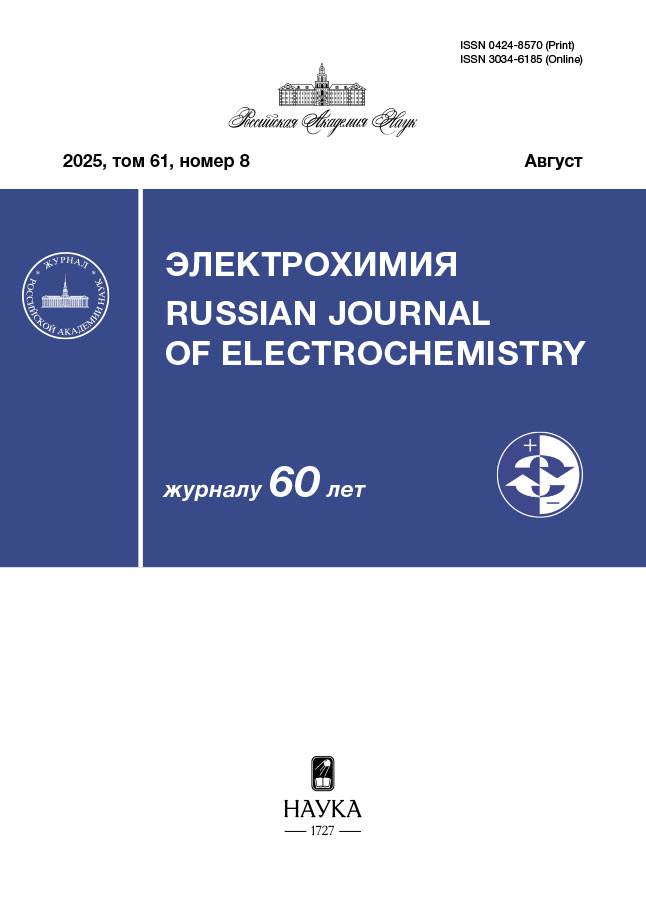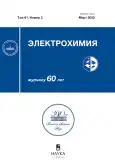Вольт-амперные и разрядные характеристики водородно-хлоратного генератора тока с сернокислым электролитом
- Авторы: Истакова О.И.1,2, Конев Д.В.1,2, Воротынцев М.А.2
-
Учреждения:
- Федеральный исследовательский центр проблем химической физики и медицинской химии РАН
- Институт физической химии и электрохимии им. А.Н. Фрумкина РАН
- Выпуск: Том 61, № 3 (2025)
- Страницы: 187-198
- Раздел: Регулярные статьи
- URL: https://journal-vniispk.ru/0424-8570/article/view/296264
- DOI: https://doi.org/10.31857/S0424857025030039
- EDN: https://elibrary.ru/DXNFAE
- ID: 296264
Цитировать
Аннотация
В работе исследовано функционирование единичной ячейки проточного водородно-галогенатного генератора тока, преобразующей энергию реакции окисления газообразного водорода хлоратом натрия в сернокислом водном растворе в электроэнергию при помощи мембранно-электродного блока состава (–) H2, Pt–C // PEM // NaClO3, C (+). Применен комбинированный режим работы нагрузки, включающий этапы потенцио- и гальваностатического контроля, учитывающий специфику протекания полуреакции электровосстановления хлората – ее редокс-медиаторный автокаталитический механизм (EC-autocat). Для водных электролитов с различным содержанием серной кислоты установлены параметры системы, определяющие мощность и эффективность функционирования водородно-хлоратного генератора тока: фарадеевская и энергетическая эффективности, средняя мощность разряда и время выхода на стационарный режим. Установлено, что наиболее эффективно изучаемая водородно-хлоратная ячейка функционирует с использованием электролита с 5 М содержанием серной кислоты: ячейка с таким электролитом выходит на режим генерации тока плотностью 0.25 А/см2 за полторы минуты, позволяет преобразовать в электроэнергию 55% энергозапаса при средней удельной мощности разряда 0.23 Вт/см2.
Полный текст
Об авторах
О. И. Истакова
Федеральный исследовательский центр проблем химической физики и медицинской химии РАН;Институт физической химии и электрохимии им. А.Н. Фрумкина РАН
Автор, ответственный за переписку.
Email: dkfrvzh@yandex.ru
Россия, Черноголовка; Москва
Д. В. Конев
Федеральный исследовательский центр проблем химической физики и медицинской химии РАН;Институт физической химии и электрохимии им. А.Н. Фрумкина РАН
Email: dkfrvzh@yandex.ru
Россия, Черноголовка; Москва
М. А. Воротынцев
Институт физической химии и электрохимии им. А.Н. Фрумкина РАН
Email: mivo2010@yandex.com
Россия, Москва
Список литературы
- Olabi, A.G., Onumaegbu, C., Wilberforce, T., Ramadan, M., Abdelkareem, M.A., and Al-Alami, A.H., Critical review of energy storage systems, Energy, 2021, vol. 214, Article number 118987.
- Rabuni, M.F., Li, T., Othman, M.H.D., Adnan, F.H., and Li, K., Progress in Solid Oxide Fuel Cells with Hydrocarbon Fuels, Energies, 2023, vol. 16, no. 17, Article number 6404.
- Lee, A.P.C. and Lee, C., It's time for an update – A perspective on fuel cell electrodes. Can. J. Chem. Eng., 2023, vol. 101, no. 11, p. 6050.
- Belhaj, I., Faria, M., Sljukic, B., Geraldes, V., and Santos, D.M., Bipolar Membranes for Direct Borohydride Fuel Cells – A Review, Membranes, 2023, vol. 13, no. 8, Article number 730.
- Muller, K., Thiele, S., and Wasserscheid, P., Evaluations of concepts for the integration of fuel cells in liquid organic hydrogen carrier systems, Energy & fuels, 2019, vol. 33, no. 10, p. 10324.
- Hassan, Q., Azzawi, I.D., Sameen, A.Z., and Salman, H.M., Hydrogen fuel cell vehicles: Opportunities and challenges, Sustainability, 2023, vol. 15, no. 15, Article number 11501.
- Braun, K., Wolf, M., De Oliveira, A., Preuster, P., Wasserscheid, P., Thiele, S., Weiss, L., and Wensing, M., Energetics of Technical Integration of 2‐Propanol Fuel Cells: Thermodynamic and Current and Future Technical Feasibility, Energy technol., 2022, vol. 10, no. 8, Article number 2200343.
- Cho, K.T., Tucker, M.C., and Weber, A.Z., A review of hydrogen/halogen flow cells, Energy Technol., 2016, vol. 4, no. 6, p. 655.
- Rubio-Garcia, J., Kucernak, A., Zhao, D., Li, D., Fahy, K., Yufit, V., Brandon, N., and Gomez-Gonzalez, M., Hydrogen/manganese hybrid redox flow battery, J. Phys. Energy, 2018, vol. 1, no. 1, Article number 015006.
- Preger, Y., Gerken, J.B., Biswas, S., Anson, C.W., Johnson, M.R., Root, T.W., and Stahl, S.S., Quinone-mediated electrochemical O2 reduction accessing high power density with an off-electrode Co–N/C catalyst, Joule, 2018, vol. 2, no. 12, p. 2722.
- Lin, G., Chong, P.Y., Yarlagadda, V., Nguyen, T.V., Wycisk, R.J., Pintauro, P.N., Bates, M., Mukerjee, S., Tucker, M.C., and Weber, A.Z., Advanced hydrogen-bromine flow batteries with improved efficiency, durability and cost, J. Electrochem. Soc., 2015, vol. 163, no. 1, p. A5049.
- Gunn, N.L., Ward, D.B., Menelaou, C., Herbert, M.A., and Davies, T.J., Investigation of a chemically regenerative redox cathode polymer electrolyte fuel cell using a phosphomolybdovanadate polyoxoanion catholyte, J. Power Sources, 2017, vol. 348, p. 107.
- Ge, G., Zhang, C., and Li, X., Multi-electron transfer electrode materials for high-energy-density flow batteries, Next Energy, 2023, vol. 1, no. 3, Article number 100043.
- Chen, R., Redox flow batteries for energy storage: Recent advances in using organic active materials, Curr. Opin. Electrochem., 2020, vol. 21, p. 40.
- VanGelder, L.E., Kosswattaarachchi, A.M., Forrestel, P.L., Cook, T.R., and Matson, E.M., Polyoxovanadate-alkoxide clusters as multi-electron charge carriers for symmetric non-aqueous redox flow batteries, Chem. Sci., 2018, vol. 9, no. 6, p. 1692.
- Laramie, S.M., Milshtein, J.D., Breault, T.M., Brushett, F.R., and Thompson, L.T., Performance and cost characteristics of multi-electron transfer, common ion exchange non-aqueous redox flow batteries, J. Power Sources, 2016, vol. 327, p. 681.
- Fang, X., Cavazos, A.T., Li, Z., Li, C., Xie, J., Wassall, S.R., Zhang, L., and Wei, X., Six-electron organic redoxmers for aqueous redox flow batteries, Chem. Commun., 2022, vol. 58, no. 95, p. 13226.
- Tolmachev, Y.V. and Vorotyntsev, M.A., Fuel cells with chemically regenerative redox cathodes, Russ. J. Electrochem., 2014, vol. 50, p. 403.
- Han, S.B., Kwak, D.H., Park, H.S., Choi, I.A., Park, J.Y., Kim, S.J., Kim, M.C., Hong, S., and Park, K.W., High‐Performance Chemically Regenerative Redox Fuel Cells Using a NO3–/NO Regeneration Reaction, Angew. Chem. Int. Ed., 2017, vol. 56, no. 11, p. 2893.
- Cho, K.T. and Razaulla, T., Redox-mediated bromate based electrochemical energy system, J. Electrochem. Soc., 2019, vol. 166, no. 2, p. A286.
- Chinannai, M.F. and Ju, H., Analysis of performance improvement of hydrogen/bromine flow batteries by using bromate electrolyte, Int. J. Hydrogen Energy, 2021, vol. 46, no. 26, p. 13760.
- Tolmachev, Y.V., Piatkivskyi, A., Ryzhov, V.V., Konev, D.V., and Vorotyntsev, M.A., Energy cycle based on a high specific energy aqueous flow battery and its potential use for fully electric vehicles and for direct solar-to-chemical energy conversion, J. Solid State Electrochem., 2015, vol. 19, p. 2711.
- Vorotyntsev, M.A., Antipov, A.E., and Konev, D.V., Bromate anion reduction: novel autocatalytic (EC″) mechanism of electrochemical processes. Its implication for redox flow batteries of high energy and power densities, Pure Appl. Chem., 2017, vol. 89, no. 10, p. 1429.
- Modestov, A.D., Konev, D.V., Antipov, A.E., Petrov, M.M., Pichugov, R.D., and Vorotyntsev, M.A., Bromate electroreduction from sulfuric acid solution at rotating disk electrode: Experimental study, Electrochim. Acta, 2018, vol. 259, p. 655.
- Modestov, A.D., Konev, D.V., Tripachev, O.V., Antipov, A.E., Tolmachev, Y.V., and Vorotyntsev, M.A., A Hydrogen–Bromate Flow Battery for Air‐Deficient Environments, Energy Technol., 2018, vol. 6, no. 2, p. 242.
- Modestov, A.D., Konev, D.V., Antipov, A.E., and Vorotyntsev, M.A., Hydrogen-bromate flow battery: can one reach both high bromate utilization and specific power? J. Solid State Electrochem., 2019, vol. 23, p. 3075.
- Campbell, A.N. and Paterson, W.G., The conductances of aqueous solutions of lithium chlorate at 25.00°C and at 131.8°C, Can. J. Chem., 1958, vol. 36, no. 6, p. 1004.
- Campbell, A.N., Kartzmark, E.M., and Maryk, W.B., The systems sodium chlorate-water-dioxane and lithium chlorate-water-dioxane, at 25°, Can. J. Chem., 1966, vol. 44, no. 8, p. 935.
- Hanley, J., Chevrier, V.F., Berget, D.J., and Adams, R.D., Chlorate salts and solutions on Mars, Geophys. Res. Lett., 2012, vol. 39, no. 8, Article number L08201.
- Konev, D.V., Goncharova, O.A., Tolmachev, Y.V., and Vorotyntsev, M.A., The Role of Chlorine Dioxide in the Electroreduction of Chlorates at low pH, Russ. J. Electrochem., 2022, vol. 58, no. 11, p. 978.
- Konev, D.V., Istakova, O.I., Ruban, E.A., Glazkov, A.T., and Vorotyntsev, M.A., Hydrogen-Chlorate Electric Power Source: Feasibility of the Device, Discharge Characteristics and Modes of Operation, Molecules, 2022, vol. 27, no. 17, Article number 5638.
- Kieffer, R.G. and Gordon, G., Disproportionation of chlorous acid. I. Stoichiometry, Inorg. Chem., 1968, vol. 7, no. 2, p. 235.
- Romanova, N.V., Konev, D.V., Muratov, D.S., Ruban, E.A., Tolstel, D.O., Galin, M.Z., Kuznetsov, V.V., and Vorotyntsev, M.A., Characteristics of the Charge–Discharge Cycle of Hydrogen–Bromine Battery with IrO2–TiO2-Titanium Felt Cathode Operating in the Full Capacity Utilization Mode, Russ. J. Electrochem., 2024, vol. 60, no. 12, p. 1061.
Дополнительные файлы















